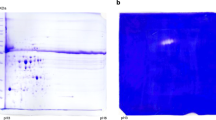Abstract
Accumulation of messenger RNAs in potato tuber discs was analysed during the hypersensitive response induced by treatment with the biotic elicitor arachidonic acid. In vitro translation of polysomal poly(A)+ RNAs indicated that the accumulation of some sixteen mRNAs varied following treatment with arachidonic acid, and that the level of thirteen of these was increased. Two cDNA closes (pSTH-1 and-2) were isolated from a library of elicitor-treated tissue cDNAs. Northern blot analysis using these clones as molecular probes indicated that the levels of at least two mRNAs were markedly increased after elicitor treatment. In hybrid-released translation experiments, each of the cDNA clones selected more than one mRNA. Translation of these mRNAs yielded two polypeptides of Mr 45 000 (for the pSTH-1 clone), and three polypeptides of Me 17 000 (for the pSTH-2 clone). The low molecular weight polypeptides may correspond to potato pathogenesis-related (PR) proteins.
Similar content being viewed by others
References
Aviv H, Leder P: Purification of biologically active globin messenger RNA by chromatography on oligothymidylic acid-cellulose. Proc Natl Acad Sci USA 69: 1408–1412 (1972).
Bell JN, Ryder TB, Wingate VPM, Bailey JA, Lamb CJ: Differential accumulation of plant defense gene transcripts in a compatible and an incompatible plant-pathogen interaction. Mol Cell Biol 6: 1615–1623 (1986).
Bostock RM, Kuc J, Laine RA: Eicosapentaenoic and arachidonic acids from Phytophthora infestans elicit fungitoxic sesquiterpenes in the potato. Science 212: 67–69 (1981).
Chappell J, Hahlbrock K: Transcription of plant defence genes in response to UV light or fungal elicitor. Nature 311: 76–78 (1984).
Conejero V, Picazo I, Segado P: Citrus exocortis viroid (CEV): protein alterations in different hosts following viroid infection. Virology 97: 454–456 (1979).
Coolbear T, Threlfall DR: A comparison of the sites of phytoalexin accumulation and of biosynthetic activity in potato tuber tissue inoculated with biotic elicitors. Phytochem 24: 2219–2224 (1985).
Friend J: Lignification in infected tissue. In: Friend J, Threlfall DR (eds) Biochemical Aspects of Plant-parasite Relationships, pp. 291–303 London: Academic Press (1976).
Giroux H, Marineau C, Brisson N: Changes in protein and mRNA accumulation in potato tubers treated with an elicitor. In: Verma DPS, Brisson N (eds) Molecular Genetics of Plant-Microbe Interactions, pp. 145–148, Dordrecht: Martinus Nijhoff Publishers (1987).
Gubler U, Hoffman BJ: A simple and very efficient method for generating cDNA librairies. Gene 25: 263–269 (1983).
Kuc J, Rush JS: Phytoalexins. Arch Biochem Biophys 236: 455–472 (1985).
Kuhn DN, Chappell J, Boudet A, Hahlbrock K: Induction of phenylalanine ammonia-lyase and 4-coumarate: CoA ligase mRNAs in cultured plant cells by UV light or fungal elicitor. Proc Natl Acad Sci USA 81: 1102–1106 (1984).
Maniatis T, Fritsch EE, Sambrook J. Molecular Cloning, a Laboratory Manual. Cold Spring Harbor, New York: Cold Spring Harbor Laboratory (1982).
O'Farrell PH: High resolution two-dimensional electrophoresis of proteins. J Biol Chem 250: 4007–4021 (1975).
Pelham HRB, Jackson RJ: An efficient mRNA-dependent translation system from reticulocyte lysates. Eur J Biochem 67: 247–256 (1976).
Preisig CL, Kuc J: Arachidonic acid-related elicitors of the hypersensitive response in potato and enhancement of their activities by glucans from Phytophthora infestans (Mont.) de Bary. Arch Biochem Biophys 236: 379–389 (1985).
Ryder TB, Cramer CL, Bell JN, Robbins MP, Dixon RA, Lamb CJ: Elicitor rapidly induces chalcone syntase mRNA in Phaseolus vulgaris cells at the onset of the phytoalexin defense response. Proc Natl Acad Sci USA 81: 5724–5728 (1984).
Sato T, Ishizuka M, Watanabe A, Imaseki H: The synthesis and properties of polysomal RNA in potato tuber slices during the early stage of aging. Plant and Cell Physiol 21: 137–147 (1980).
Sequeira L: Mechanisms of induced resistance in plants. Ann Rev Microbiol 37: 51–79 (1983).
Smith MA: Quantitation of chloroplast DNA using dot blot filter hybridization with double-stranded probes. Mol Cell Biochem 63: 149–156 (1984).
Somssich IE, Schmelzer E, Bollmann J, Hahlbrock K: Rapid activation by fungal elicitor of genes encoding “pathogenesis-related” proteins in cultured parsley cells. Proc Natl Acad Sci USA 83: 2427–2430 (1986).
Tjamos EC, Kuc J: Inhibition of steroid glycoalkaloid accumulation by arachidonic and eicosapentaenoic acids in potato. Science 217: 542–544 (1982).
VanLoon LC: Pathogenesis-related proteins. Plant Mol Biol 4: 111–116 (1985).
Author information
Authors and Affiliations
Rights and permissions
About this article
Cite this article
Marineau, C., Matton, D.P. & Brisson, N. Differential accumulation of potato tuber mRNAs during the hypersensitive response induced by arachidonic acid elicitor. Plant Mol Biol 9, 335–342 (1987). https://doi.org/10.1007/BF00014908
Received:
Accepted:
Issue Date:
DOI: https://doi.org/10.1007/BF00014908




